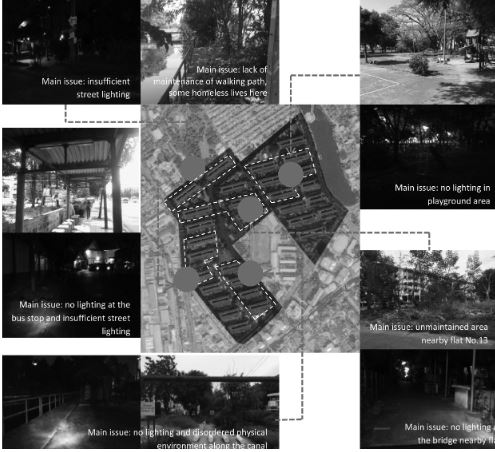Analysis of Community Safety Conditions of an Old Public Housing Project: Case Study of Klong Chan Flat, Bangkok
Keywords:
Community safety, Crime, Safety management, Public housingAbstract
Safety, in regards of all aspects, is considered a major priority to community. The residents perceived their safety through physical surroundings of living places. Accordingly, a long-established, old public housing community with open access, Klong Chan Flat, was chosen to be examined regarding safety issues through field survey and questionnaire. The results showed Klong Chan Flat is divided into three scale of safety-concerned areas; dwellings (installed with window and door grilles), buildings (provided with CCTV, lighting, and motorcycle docking), and community (stationed with a police check-point). The overall satisfaction towards community safety of residents staying in buildings with fully provided CCTV, lighting, motorcycle docking, and unsafe community area resulted in a significant relationship of these variables at .05. The motorcycle docking and lighting are found to be an important element of building safety with its high correlation value at .631 and .507 respectively. In addition, five significant spots evidenced with high criminal incidents were identified through an interview from residents and police information. Consequently, more surveillance must be acted upon and focused on physical conditions as well as building maintenance and management. These results conferred a baseline data of initial investigation of old public housing project towards safety issues. Thus, these significant factors are to be determined in terms of safety management to enhance standard and quality of living of the residents staying in Klong Chan Flat and contributed to more in-depth study afterwards.
Downloads
References
Australian Institute of Criminology. (2015). Effective crime prevention interventions for implementation by local government. Retrieved from http://www.aic.gov.au/publications/current%20series/rpp/100-120/rpp120/07_approaches.html.
Bonnefoy, X. (2007). Inadequate housing and health: an overview. International Journal of Environment and Pollution, 30(3–4), 411–429.
Braubach, M., & Fairburn, J. (2010). Social inequities in environmental risks associated with housing and residential location--a review of evidence EuropeanJournal of Public Health, 20(1), 36-42.
City of Darebin. (2012). Community safety strategy 2012– 2016. Retrieved from http://www.darebin.vic.gov.au/-/media/cityofdarebin/Files/Darebin-Living/CommunitySupport/CommunitySafety/Community_Safety_Strategy.ashx?la=en.
Daily News. (2015, Octorber 17). Monitoring Latphrao police station. Retrieved from http://www.dailynews.co.th/crime/354945.
Davidson,M.(2009).Perception of safety and fear of crime. In: D.Ormandy (Ed.),Housing and Health in Europe. New York: Routledge.
Freedman, M., & Owners, E. (2010). Low-Income housing development and crime. Retrieved from http://socrates.berkeley.edu/~raphael/IGERT/Workshop/Matt%20Friedman%20-%20Fall%202010.pdf.
Fuji, Y., & Kawata, A. (2007). Study on evaluation method of residential environment in residential area level. Journal of The Japanese Institute of Landscape Architecture, 69(5), 799-802.
Kawachi, I., Kennedy, B. P., & Wilkinson, R. G. (1999). Crime: Social disorganization and relative deprivation. Social Science & Medicine, 48(6), 719–731.
Khaosod. (2015, Octorber 17). Police general visits Latphrao police station. Retrieved from http://www.khaosodonline.com/view_newsonline.php?newsid=1445078877.
Kihl, M., Brennan, D., Gabhawala, N., List, J., & Mittal, P. (2005). Livable communities: An evaluation guide. Washington, USA.: AARP.
Kullberg, A. (2010). My home is my castle: residential well being and perceived safety in different types of housing areas in Sweden. (Ph.D. dissertation). Faculty of Health Sciences, Linkoping University. Retrieved from http://liu.diva-portal.org/smash/get/diva2:355507/FULLTEXT01.pdf.
Lawrence, R. J. (2002). Healthy residential environments. In R. B. Bechtel, & A. Churchman (Eds.). Handbook of environmental psychology (pp. 394-411). New York:John Wiley.
Lawrence, J., & Ruth, D. (1996). Extremely disadvantaged neighborhoods and urban crime. Social Forces Journal, 75(2), 619-648.
Latphrao Police Station (2016, November). Secondary data of crime Statistic in Latphrao District. Bangkok, Thailand: Authors.
Lujanen, M. (2001). Boende och bostadspolitik I Norden (Housing and housing policy In the Nordic countries). Kopenhamn: Nordiska Ministerrdet (in Swedish).
Macintyre, S., Maciver, S., & Sooman, A. (1993). Area, class and health should we be focusing on places or people?.Journal of Social Policy, 22, 213–234.
Macintyre, S., Ellaway, A., & Cummins, S. (2002). Place effects on health: how can we conceptualise, operationalise and measure them?. Social Science & Medicine, 55(1), 125–139.
Matthew. F., & Emily. G. O. (n.p). Low-Income housing development and crime. Retrieved from http://paa2011.princeton.edu/papers/110122.
Mhankatidham, V. (2015). Factors affecting crime in relation to the physical environment of the slum. International Conference, Suan Sunandha Rajabhat University, (pp. 220-228). Retrieved from http://www.teacher.ssru.ac.th/winai_ma/file.php/1/Research/Tewaraj_layout.pdf.
National Housing Authority [NHA]. (2014). Affordable housing development standard for low and middle income people. Retrieved from http://www.nha.co.th/ewt_news.php?nid=14957&filename=index.
Newman, O. (1973). Defensible space: People and design in the Violent city. New York:McMillan
Ormandy, D. (Ed.). (2009). Housing and health in Europe. New York: Routledge.Royal Thai Police. (2007). Crime prevention through environmental design. Retrieved from http://highway.police.go.th/theory/CPTED.pdf.
Saunders, M., Lewis, A., & P., Thornhill, A. (2009). Research methods for business students. London, England: Pearson Education.
Srisopon, S. (2012). Safety and sense of safety from crime in the environment of old community, Phra Nakhon District, Bangkok: A case study of Trok Sin-Trok Tuek Din Community. Veridian E-Journal, Silpakorn University, 8(1), 1517-1533.
Wendel Vos, W., Droomers, M., Kremers, S., Brug, J., & van Lenthe, F. (2007). Potential environmental determinants of physical activity in adults: a systematic review. Obesity Reviews, 8(5), 425–440.
Wilson, J. Q., & Kelling, G. L. (1982). Broken windows. Atlantic Monthly, 249(3), 29–38.
Wilson, W. J. (1987). The truly disadvantaged: The inner city, the underclass, and public policy. Chicago, IL, USA: University of Chicago Press.
Whitzman, C. (2008). Community safety indicators: are we measuring what counts?. Urban Policy and Research, 26(2), 197–211.
Yiampisan, M., and Srivanit, M. (2010). Using the Kernel Density Estimation Surface for Criminal Pattern: A Case Study in Phranakhon District, Bangkok. Journal of Architectural/Planning Research and Studies, 7(1), 87-102.

Downloads
Published
How to Cite
Issue
Section
License
Copyright (c) 2017 International Journal of Building, Urban, Interior and Landscape Technology (BUILT)

This work is licensed under a Creative Commons Attribution-NonCommercial-NoDerivatives 4.0 International License.











